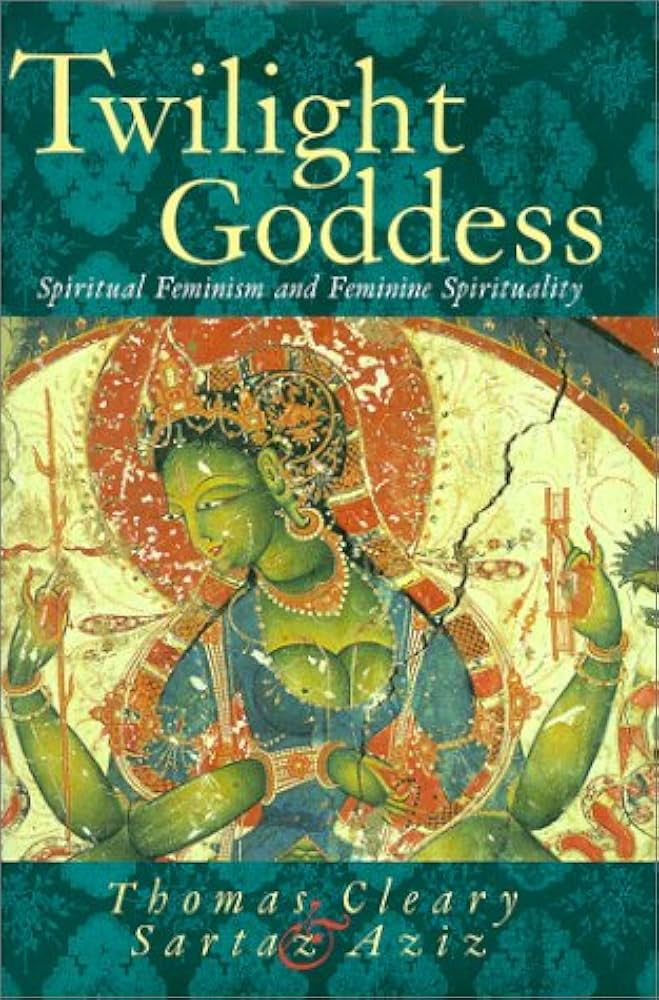This is an interesting survey of the Divine Feminine in religions of south and east Asia – in Hinduism, Taoism, Buddhism, and the Sufi tradition of Islam. Despite the Patriarchal overlay, the energy of the feminine persists.
Cleary and Aziz tell stories of divine women and saints, goddesses, and archetypes. In both hidden and overt symbolism, they explore feminine principles, symbols, and imagery found throughout the region and give thoughtful meditations on the meanings of these manifestations of the Divine. They discuss deeper cultural roots as well, ideas about purity and contamination, power and authority, and histories of migration and cultural hybridization which influenced the development of these religious ideas and practices.
The authors draw substantially from tantra, as a folk practice of ecstatic trance centred on feminine energy and loving union between feminine and masculine, underlying both the Hindu and Buddhist official religion and with great similarities to (and influences from) folk Taoist magical practices. They emphasize, also, the theme of goddess religion as resistance to patriarchal culture and politics. They meditate on both facets of the goddesses, light and darkness, life and death.
They introduce us in the first chapter on the Divine Matrix to Indian goddesses like Rri (seen as resembling Dana in Ireland – there is a lot of ‘primordial tradition’ and syncretism in the book), Devi, Maya, Kali. In the next chapter on Tantra, we meet Tara and have a thorough discussion of the seven main paths of tantra, with sacred sexuality placed in a context of other spiritual skills and attainments, and a discussion of women priests inside these paths. The next chapter on the Goddess of Rebellion deals largely with Kali and the antinomian and rebellious worshippers – the brigands, thugees, and other outcasts – as well as introducing us to the ten Mahavidyas of Great Knowledge, aspects of this dangerous feminine energy of creation and destruction. This is a sophisticated and useful discussion of these goddesses.
The next chapters move to a discussion of Chinese folk Taoism beginning with a discussion of the idea of yin, the feminine principle, and its development and symbolism in the history of China. The next chapter on Usurping the Yin deals with the emergence and dominance of Confucian patriarchal ideals and the subordination of women and suppression of Taoism, so that the Taoist sex magic and feminine magic was driven into the shadows. The next chapter on Women of the Way gives brief biographies and accounts of Taoist women mystics and leaders. The next two chapters deal with Taoist sexology and Taoist secret societies, the second in not as much detail.
Then follow several chapters on Buddhism, following the same pattern as the previous two sections – dealing with the primordial feminine in the tradition (Goddess of Wisdom), with women leaders and teachers (Wakeful Women), telling the history of the development and spread of the tradition from India into Tibet, and in a substantial chapter on Buddhist Tantra (Lotus and the Thunderbolt). The Tantra chapter also discusses elements from Taoism and the Bon tradition of Tibet that were incorporated into Buddhism there. The section concludes with a brief discussion of Pure Land Buddhism and the goddess / bodhisattva Kwannon.
Four chapters on the Sufi branch of Islam close out the book, providing illuminating discussion of attitudes toward women in Islam in general and this mystical minority tradition (which is, however, a strong current in Pakistan and India). They discus parallels between Sufi ideas and those discussed earlier in the book. The declaration of the fundamental equality of women and men in the Qur’an, the reverence for the womb in Islam as shown in various hadiths of Muhammad (pbuh), and the lore of saintly women in Sufism together with several short biographical sketches are all very interesting. The final chapter discusses Islam as a religion of community and complementarity of women and men.
They provide condensed and lively histories of developments in India, China, and Japan and a sophisticated discussion of the feminine spiritual as it developed through time. They also frequently draw parallels between these religious traditions and show similarities in approach. As a wide-ranging survey, they can only introduce us to these goddesses and influences, but the selected bibliography points to sources for further reading and research.
~review by Samuel Wagar
Author: Thomas Cleary and Sartaz Aziz
Shambhala Publications, 2000
275 pg. Paperback £15 / $27 Can / $20 US

